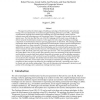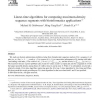95 search results - page 10 / 19 » bioinformatics 2002 |
SIGCSE
2002
ACM
13 years 7 months ago
2002
ACM
Bioinformatics is a new and rapidly evolving discipline that has emerged from the fields of experimental molecular biology and biochemistry, and from the the artificial intelligen...
TITB
2002
13 years 7 months ago
2002
This paper describes the initial stages of building an ontology of bioinformatics and molecular biology. The conceptualisation is encoded using the Ontology Inference Layer (OIL),...
CORR
2002
Springer
13 years 7 months ago
2002
Springer
an abstract optimization problem arising from biomolecular sequence analysis. For a sequence A of pairs (ai, wi) for i = 1, . . . , n and wi > 0, a segment A(i, j) is a consecu...
TITB
2002
13 years 7 months ago
2002
The complex questions and analyses posed by biologists, as well as the diverse data resources they develop, require the fusion of evidence from different, independently developed ...
BIOINFORMATICS
2002
13 years 7 months ago
2002
Motivation: Typical analysis of microarray data has focused on spot by spot comparisons within a single organism. Less analysis has been done on the comparison of the entire distr...


